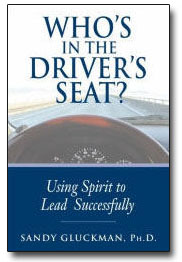I will spare you (and myself) a description of the unprecedented economic events of the past sixteen months. We all know what has happened  and the impact this is having on every one of us. So with that as the background, let me tell you a tale of two leaders and how each deals with their stress differently. The first is George (you might have met him in my book, Who’s in the Driver’s Seat. )
and the impact this is having on every one of us. So with that as the background, let me tell you a tale of two leaders and how each deals with their stress differently. The first is George (you might have met him in my book, Who’s in the Driver’s Seat. )
George is a highly intelligent and talented guy. Like most leaders attempting to build a sustainable organization and keep their jobs in this challenging economy, George is pretty stressed. But George is not managing his stress very well. Unmanaged stress is a terrible thing. It’s like leaking water – it creeps into every corner, leaving damage everywhere that it goes.
George’s way of dealing with stress is to become more authoritarian than ever before (quite unconsciously, of course). It’s as if this flight to authority gives him a sense of control over the unpredictability of his life. Perhaps it helps him manage his fear and anxiety. So he uses his status and authority to try and drive performance. You would think authority and status would give him the clout and power to influence people to meet his expectations. Not so! His team members are underperforming and his department is delivering really poor results. And the poorer the results are, the more he flees to being the boss and uses authority as a stick; and the more he does this, the poorer the performance becomes.
Tuned out and switched off
 It seems that George’s team members have decided that the best way to deal with their boss is to tune out, withdraw and disengage. This way the boss feels ‘okay’ because nobody is challenging his authority; and the team members feel ‘okay’ because by switching off they can keep their emotions in neutral. The problem is that tuned-out people, driving in neutral, can only deliver disinterested and neutral performance. It is amazing that for such a highly intelligent person, George is unable to see the relationship between his authoritarian reaction to stress and the poor results his department is delivering.
It seems that George’s team members have decided that the best way to deal with their boss is to tune out, withdraw and disengage. This way the boss feels ‘okay’ because nobody is challenging his authority; and the team members feel ‘okay’ because by switching off they can keep their emotions in neutral. The problem is that tuned-out people, driving in neutral, can only deliver disinterested and neutral performance. It is amazing that for such a highly intelligent person, George is unable to see the relationship between his authoritarian reaction to stress and the poor results his department is delivering.
And then there is George’s colleague Dave (the other character in my book). He is also stressed, being faced with the same business challenges as George is, but he manages his stress differently. The way he manages his stress is to become hyper-communicative, hyper-participative and hyper engaged. It seems to be working because his department is producing the best results in the company.
Alive and well.
If you ask Dave how he is able to do this, he says it is because the people reporting to him are (and I quote…) ‘alive and well.’ Of course, everyone asks him what he means by this and his explanation is that they are involved, participative, excited, inspired, outspoken and courageous. If you ask him how it came about that he has so many ‘alive and well’ people around him, he shrugs his shoulders. Dave is too modest to say that his people are ‘alive and well’ because he doesn’t play ‘boss.’ When he is stressed and under pressure to deliver results, he exerts leadership influence by sharing his concerns, inviting heated debate, providing the climate for dialogue, brainstorming innovative solutions, using 1+1=3 thinking and telling his team that he does not know the answers and cannot move forward without them.
asks him what he means by this and his explanation is that they are involved, participative, excited, inspired, outspoken and courageous. If you ask him how it came about that he has so many ‘alive and well’ people around him, he shrugs his shoulders. Dave is too modest to say that his people are ‘alive and well’ because he doesn’t play ‘boss.’ When he is stressed and under pressure to deliver results, he exerts leadership influence by sharing his concerns, inviting heated debate, providing the climate for dialogue, brainstorming innovative solutions, using 1+1=3 thinking and telling his team that he does not know the answers and cannot move forward without them.
So what is the moral of this tale of two leaders?
Leadership is best reserved for those who don’t need to validate who they are.
Or maybe the moral of the story is that great leaders know how to exert influence without using authority and status.
What do you think?

